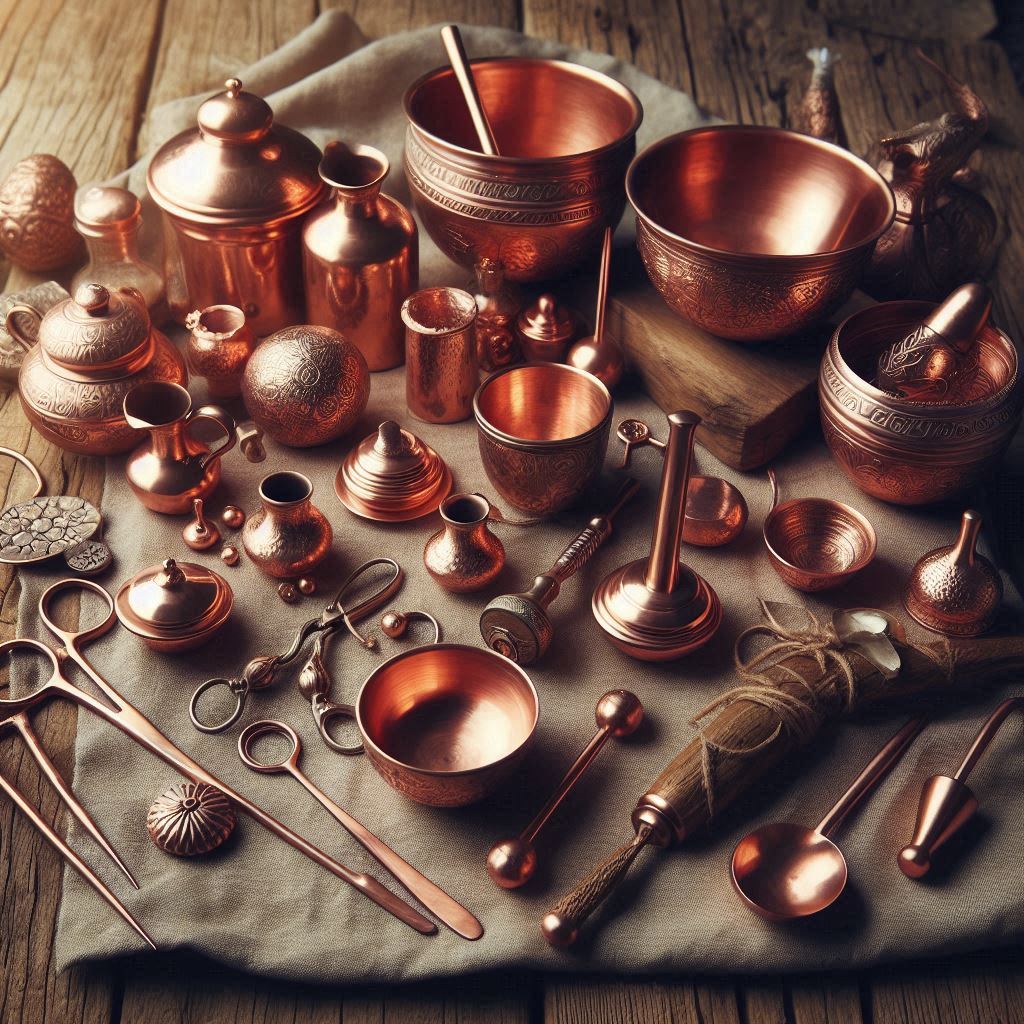Introduction : Historical Significance of Copper in Medicine
A Timeless Elixir
Copper, a lustrous and versatile metal, has been crucial to human history for thousands of years. Its malleability and durability made it an essential material for tools and weapons. However, the historical significance of copper in medicine extends far beyond these practical uses. This metal has played a vital role in ancient medicine, a history that dates back to the very beginning of human civilization.
Copper in Ancient Egypt: A Divine Metal
Ancient Egyptians held copper in high regard, considering it a divine gift. They understood and utilized its antimicrobial properties for various medical purposes. Copper tools were used in surgeries, believed to prevent infections and support healing. Furthermore, the Egyptians created copper-based remedies to treat various ailments, including skin conditions and eye diseases.
The historical significance of copper in medicine is evident in the Egyptians’ extensive use of this metal. By examining their techniques, we gain valuable insights into early medical practices. Their use of copper-based treatments highlights how ancient knowledge laid the groundwork for modern medical practices.
Copper in Traditional Chinese Medicine (TCM)
Historical Significance of Copper in Ancient Chinese Medical Literature
Traditional Chinese Medicine (TCM) boasts a rich history that integrates various elements and substances into its healing practices. Although specific references to copper are less common compared to herbs and minerals, TCM practitioners emphasized the concept of “metal energy.” They believed that copper, as a metal, resonated with specific energetic qualities that were beneficial for therapeutic purposes.
Ancient Chinese medical texts, such as the “Yellow Emperor’s Inner Canon” and the “Compendium of Materia Medica,” discuss the importance of metal elements in maintaining health. While these texts might not directly address copper, they emphasize the role of metal in holistic healing. This reflects the historical significance of copper in medicine and its integration into broader TCM practices.
Historical Significance of Copper in Medicine Applications and its Benefits in TCM
TCM practitioners believed copper influenced the body’s vital energy, or Qi. By incorporating copper into various therapies, they aimed to restore balance and harmony.
- Acupuncture: Practitioners occasionally used copper needles in acupuncture, believing that copper enhanced the conductivity of Qi and led to more effective treatments.
- Cupping Therapy: Cupping therapy involved creating suction on the skin to improve blood flow and relaxation. Practitioners might have used copper cups, which provided the added benefit of copper’s antimicrobial properties.
- Balms and Ointments: Copper-containing balms and ointments likely treated skin conditions and wounds. Copper’s antimicrobial and anti-inflammatory properties made these preparations valuable.
- Water Purification: The Chinese recognized the importance of clean water. They used copper vessels to store water, believing that copper purified the water and provided beneficial properties.
Although less documented compared to herbal remedies, copper’s inclusion in TCM highlights its historical significance in medical practices. The belief in copper’s ability to balance the body and promote healing underscores its lasting appeal.
Copper’s Antimicrobial Properties: A Modern Marvel with Ancient Roots
Scientific Validation: Microbial Slayer and Historical Significance of Copper in Medicine
Modern science has confirmed copper’s powerful antimicrobial properties. Studies have shown its effectiveness in killing a wide range of bacteria, including those responsible for hospital-acquired infections. Copper ions released from the metal disrupt microorganisms’ cellular functions, leading to their destruction. This mechanism is different from many antibiotics, reducing the risk of bacterial resistance.
The U.S. Environmental Protection Agency (EPA) recognizes copper’s antimicrobial properties, officially registering copper alloys for public health claims. This endorsement underscores the historical significance of copper in medicine and its efficacy in combating harmful pathogens.
Ancient Knowledge: A Prescient Understanding and Historical Significance of Copper in Medicine
Ancient civilizations intuitively grasped copper’s antimicrobial potential. Egyptians, for instance, used copper tools in surgery, likely reducing infection risks. Their use of copper vessels for water storage indicates an understanding of its purifying abilities.
Other ancient cultures, such as the Greeks and Romans, also incorporated copper into healthcare practices. Copper-based remedies and medical instruments were common, reflecting a deep-seated belief in the metal’s healing properties. This historical significance of copper in medicine is evident across various ancient civilizations.
Historical Significance of Copper in Ancient Greek and Roman Medicine
Historical Significance of Copper in Greek Practices: Hippocrates and Copper
Hippocrates, often called the “Father of Medicine,” recognized the historical significance of copper in medicine. His empirical approach led him to explore copper’s applications in medical treatments. Notably, Hippocrates used copper-based powders and ointments for wound care, appreciating copper’s ability to prevent infection and promote healing.
Hippocrates also explored copper’s benefits for treating skin diseases. His observations, though not scientifically detailed, highlighted copper’s effectiveness in dermatological treatments.
Historical Significance of Copper in Roman Innovations
The Romans were renowned for their engineering and public health advancements. They understood the importance of clean water for disease prevention, constructing extensive aqueduct systems using copper pipes to transport water. Copper’s antimicrobial properties helped maintain water quality, reducing the spread of waterborne diseases.
Roman public baths, crucial for hygiene and social interaction, also utilized copper. The metal’s antimicrobial nature contributed to a cleaner environment within these establishments. Rome’s emphasis on public health and copper’s strategic use in infrastructure showcased their advanced understanding of preventive medicine. This further emphasizes the historical significance of copper in medicine.
Comparative Analysis: Historical Significance of Copper in Medicine Across Cultures
Cross-Cultural Uses
Copper’s remarkable properties were recognized and utilized across various ancient civilizations. Despite differing applications, a common belief in copper’s healing potential united these cultures.
- Egypt: The Egyptians revered copper as a divine metal, using it extensively in surgical tools and remedies.
- Mesopotamia: Mesopotamians crafted surgical instruments and medical tools from copper alloys, incorporating copper-based remedies into their practices.
- India: Ayurvedic medicine viewed copper as vital for balancing doshas. Copper vessels were used for water storage, and copper-infused oils were applied to the skin.
- China: TCM included copper in acupuncture, cupping therapy, and water purification, valuing its role in balancing energy and promoting healing.
- Greece and Rome: Hippocrates and the Romans recognized copper’s therapeutic uses, from wound care to public health infrastructure.
Common Themes
Several themes emerge from the use of copper across cultures:
- Antimicrobial Properties: Ancient civilizations universally recognized copper’s ability to kill bacteria and prevent infections.
- Wound Healing: People commonly used copper to treat wounds, reducing inflammation and promoting healing.
- Water Purification: Storing water in copper water bottles and vessels became a widespread practice to enhance water quality.
- Surgical Applications: Surgeons employed copper tools and instruments in surgeries and medical treatments.
- Holistic Approach: Healers integrated copper into broader healing philosophies, often linking it to spiritual or metaphysical beliefs.
These shared beliefs underscore the historical significance of copper in medicine. Its effectiveness has transcended time and cultural boundaries, forming a foundation for modern medical practices.
Modern Relevance of Ancient Practices
Contemporary Applications
As interest in natural and holistic medicine grows, ancient practices involving copper are experiencing a resurgence. Hospitals now incorporate copper into designs, with copper-coated surfaces helping to reduce bacterial spread. This practical application of ancient wisdom enhances healthcare environments.
Health Benefits
Modern science is validating ancient beliefs about copper’s health benefits. Consuming water stored in copper water bottles or using copper-rich products can potentially enhance well-being. Copper plays a role in immune support, energy production, and iron absorption.
Copper peptides, found in many skincare products, offer antioxidant and anti-inflammatory benefits. They help protect skin, promote collagen production, and reduce wrinkles. The historical significance of copper in medicine continues to find relevance in contemporary health and wellness practices.
Conclusion
Copper’s historical significance in medicine is profound. From ancient Egypt and Greece to Mesopotamia and China, copper was valued for its healing properties. Modern science now confirms ancient knowledge, highlighting copper’s antimicrobial and health benefits. The historical significance of copper in medicine is undeniable, influencing practices from wound care to public health.
The historical significance of copper in medicine provides a promising foundation for future research and development. As our understanding of microbiology and human physiology continues to evolve, we can anticipate innovative applications of copper in healthcare. For instance, copper-based antimicrobial coatings have the potential to revolutionize infection control in hospitals and public spaces. Furthermore, delving into copper’s role in nanotechnology may lead to groundbreaking advancements in drug delivery and medical devices.
The growing interest in natural and holistic health approaches also signals a bright future for copper. The best copper water bottles at The Amrit Life and other copper-infused products are increasingly popular as consumers seek alternatives to synthetic materials. With ongoing research revealing more about copper’s benefits, we can expect to see a wider integration of this ancient metal into modern wellness practices.
In summary, the historical significance of copper in medicine highlights its enduring value. By combining the wisdom of ancient practices with contemporary scientific advancements, we can unlock copper’s full potential. This approach promises to enhance human health and well-being, benefiting generations to come. Through the intersection of historical insight and modern science, we stand to harness copper’s remarkable properties to make a lasting impact on our future.











